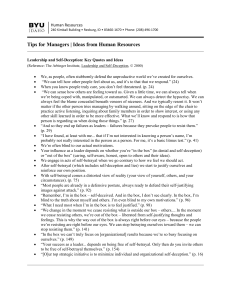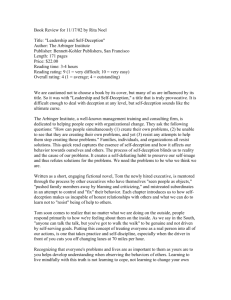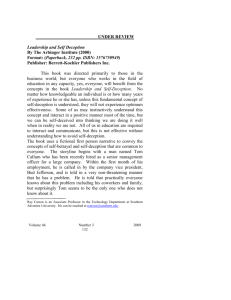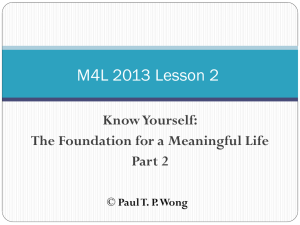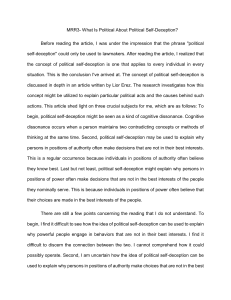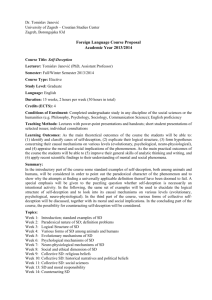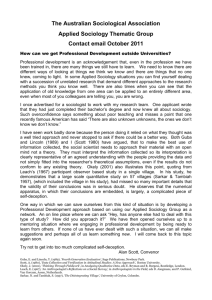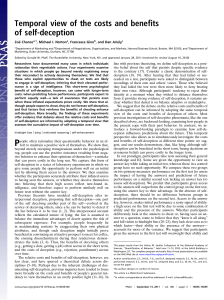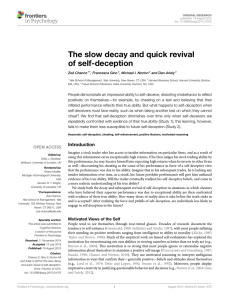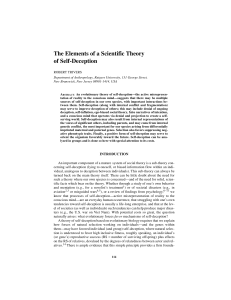Getting Out of the Box Leadership and Self
advertisement
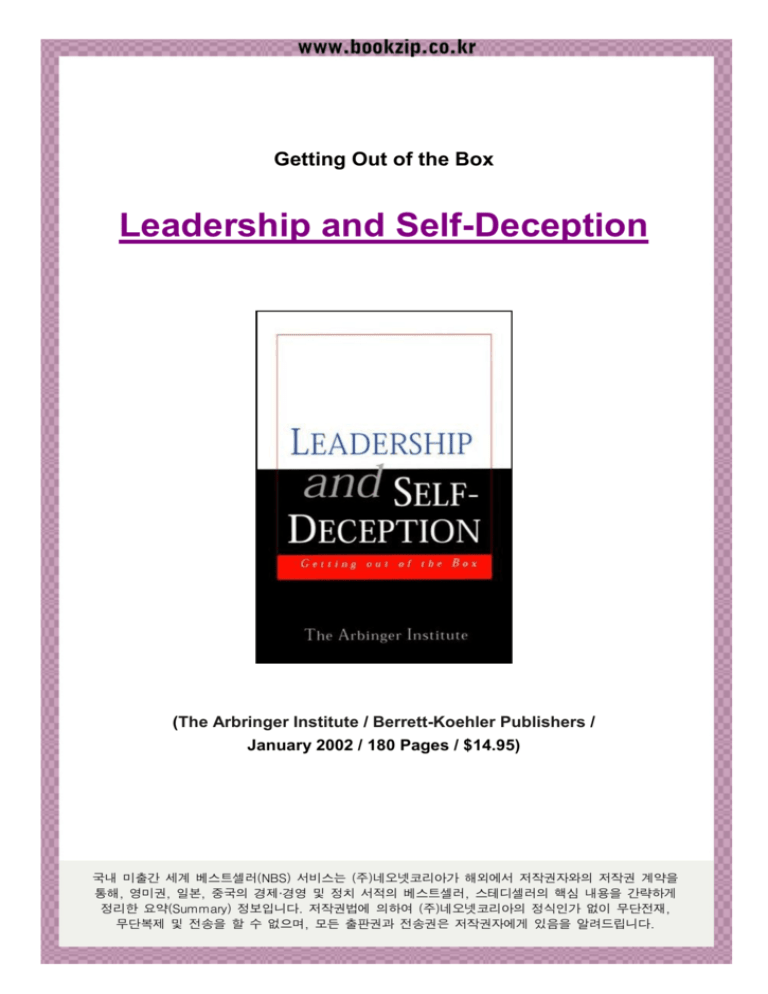
Getting Out of the Box Leadership and Self-Deception (The Arbringer Institute / Berrett-Koehler Publishers / January 2002 / 180 Pages / $14.95) 국내 미출간 세계 베스트셀러(NBS) 서비스는 (주)네오넷코리아가 해외에서 저작권자와의 저작권 계약을 통해, 영미권, 일본, 중국의 경제·경영 및 정치 서적의 베스트셀러, 스테디셀러의 핵심 내용을 간략하게 정리한 요약(Summary) 정보입니다. 저작권법에 의하여 (주)네오넷코리아의 정식인가 없이 무단전재, 무단복제 및 전송을 할 수 없으며, 모든 출판권과 전송권은 저작권자에게 있음을 알려드립니다. Leadership and Self-Deception Getting Out of the Box The Big Idea How would you react if you were told by your top boss that you have a problem and that problem is you ? only you don’t know how on earth you can be THE problem? Sounds confusing, doesn’t it? Well, in this simple, practical, enlightening, maybe even life-changing business book from the Arbringer Institute, you’ll find that at the center of most organizational problems is the human frailty of Self-Deception. With its easy-to-read narrative style and analogy by common life examples, you’ll find the concepts and principles adaptable to any work environment. Sometimes, you’ll hardly feel that you’re reading a business book because the subject is deeply rooted on how you behave as an individual, as a person and thus, may also be applied to your everyday life. About the Author The Arbringer Institute BYU philosophy professor C. Terry Warner, '63, never set out to be an organizational consultant, but in the late 1970s, Stephen R. Covey, learned about his work on self-betrayal and thought the concepts might help one of his clients. Using Warner's ideas, the company went from being nearly torn apart by internal conflict to becoming the most profitable company in the steel service industry. In this experience Warner discovered that working with organizations could provide him with a laboratory of living subjects that anchored his theoretical work to practical realities and motivated thousands of people to share stories with him. At a crucial point, Warner was counseled by the BYU administration to develop and gain legitimacy for his ideas off campus as practical tools for helping people. In 1992, he let his occasional consulting practice expand into a small company, The Arbinger Institute, and three key employees were made partners in the mid 1990s. On three occasions Warner has taken a one-year leave of absence from BYU or had his time purchased to work fulltime on Arbinger projects. Otherwise he has averaged only a day or two a year on Arbinger concerns. His partners, whom he calls "princely men of great ability," have developed and run the institute. He didn't even read the institute's best-selling book, Leadership and Self-Deception, until it was published, though it is based solely on his previous works. Introduction This book starts with a meeting between Bud Jefferson, Executive Vice President of Zagrum Company, and Tom Callum, newest Senior Manager to one of Zagrum’s product lines. This kind of meeting has been a tradition in the company that all new senior management personnel are expected to participate in. The first thing that Bud told Tom after all the pleasantries have been dispensed was that Tom had a problem and that he himself was unaware of it. This bit of information confused Tom but he waited patiently for the explanation. This explanation took two days to unravel… -2- Part One - Self-Deception and the Box On the first day of the meeting, Bud tried to explain to Tom the presence of Self-Deception and its tenacious hold on every human being. He asked Tom to think of a person in his previous company whom he believed to be an impediment to teamwork. This person was so full of himself that he’s a classic case for self-deception. Its grip was so strong yet so subtle as to be non-existent to this person with the problem. Bud also discussed other analogous situations with Tom and thus defined Self-Deception and the Box. It is the case of everyone in your organization thinking you’re the problem except that you’re not even aware or are even in denial of such a possibility. Here, you will find that self-deception or being “in the Box” is the main reason, albeit unknowingly, why leaders fail. Self-Deception - Being in the Box Self-deception is likened to being in the box because it seems that you’re shut in a box with no other external stimulus coming in except your own closed perspective. For instance, you may think that you’re committed, totally devoted and engaged in a project ? giving it your all, forsaking holidays and special personal occasions for work ? and yet, based on other people’s observations, you are NOT. Since you don’t and can’t see it from your point of view, it makes you take a defensive stance and even come to believe that other people are against you. Self-Deception - The Disease in the Organization This inability to see that the problem lies within you carries its weight on the relationship you have with your peers and ultimately translates itself on the performance of your group. This happens whether you’re at the helm of a Fortune 500 company or heading a smaller group within a larger organization. You may think that your people skills are influencing your team members into producing great results. However, it may just be the other way around! In fact, it takes more than that to be effective in establishing a good rapport with your employees, co-workers and team members. Your success will come from a sincere desire to learn about them. People can detect even the slightest hint of hypocrisy and manipulation and leaders fail because they provoke the people to resist them by such behavior. Are you IN or OUT of the box? The most basic test in determining whether you’re in or out of the box is when you try to be interested in knowing the people under you, or at least even match their names with faces for starters. Your lack of interest in something as basic as this keeps you IN the box. You don’t regard them as people - only as objects within your organization. You decide that your needs come before anybody else’s and that basically these needs should be satisfied first and pity for those who come in second. Being OUT of the box means you’re placing your needs as well as the need of others on the same level. You are all equal. If it’s as simple as people treating others as people (including all the hard work and training that go with the job), most companies will have a shot at reaching the top. The motivation for smart people to be smarter and for skilled people to be even more skilled is for them to be treated in a straightforward manner, and -3- to give them the respect and dignity they deserve. Part Two - How we get in the Box During their lunch break, after accepting some truth in what Bud said, Tom decided to right some wrongs he has done to some of his colleagues. Feeling good about himself, more from the fact that he finally understood what it meant to be out of the box with someone, he promptly called his wife, Laura. Unfortunately, things didn’t go as he hoped and he then began to have more questions about The Box. Then, Kate, the President of the company made a surprise appearance. Knowing that you’ve already distinguished the merits of being out of the box, what will prompt you to get into the box again? The answer is simple yet its ramifications may be complicated: The 7 Principles of Self-Betrayal. By offering examples and situations by way of explanation, you will find it easier to understand the concepts. These situations are so common that at any point of your life, you may have done these along with the rest of the human race. 1. An act contrary to what I feel I should do for another is called an act of “self-betrayal”. Have you ever found yourself in a situation where a colleague needed some information for a project and you didn’t share this with him even though you knew it was crucial to the project’s success? Or consider this situation: a simple matter of not holding the elevator for someone who was obviously rushing to get to it. By not choosing to honor what is obviously the right thing to do, you have just betrayed yourself. 2. When I betray myself, I begin to see the world in a way that justifies my self-betrayal. You now try to minimize the effect of your self-betrayal by rationalizing your behavior. You may conjure up all sorts of excuses and reasons for your action. 3. When I see a self-justifying world, my view of reality becomes distorted. In the process, you make it to be the other person’s fault. What happened was his mistake. You, on the other hand, didn’t do any misbehavior at all. You may even attribute exaggerated characteristics to the other person to make you appear as the victim in the situation. 4. So ? when I betray myself, I enter the box. Now that you’ve convincingly turned the situation in your favor through self-betrayal, you have become Self-Deceived, hence you’re IN the box. You amplify others’ “flaws”, you boost your own value, you exaggerate the value of things that justify your self-betrayal and then you blame other people for your predicament. 5. Over time, certain boxes become characteristic of me, and I carry them with me It is inevitable that you may betray yourself repeatedly in the same situations, but in -4- different environments. Eventually, this may become part of your “reality”, part of who you are. For instance, if you continuously justify yourself as being a good worker, chances are that you believe that you are, although others may beg to disagree. 6. By being IN the box, I provoke others to be in the box Believing in this truth, when people try to tell you otherwise, you become belligerent and defensive. You see these people as threats, but to those who feed your “fantasy”, you believe them to be your allies. Being IN the box with a self-justifying view of yourself, you elicit an equally negative reaction from the people surrounding you. They either help you but with the minimum amount of effort or remain totally uncooperative. 7. In the box, we invite mutual mistreatment and obtain mutual justification. We collude in giving each other reason to stay in the box This vicious cycle ? with your perverted view of the situation and the equally perverted response from the other party ? becomes a “collusion” in which you feed each other’s need for justification. To better understand the concept of collusion, have you ever been in a situation at work where you see one of your junior colleagues consistently under-performing? Being the higher authority, you “talk” to him about it, but instead, he sees it as you distrusting his output or even using your higher position over him. In response, he simply disregards your “advice” and continues with his usual level of work. What happens then is that your perverted perceptions of your co-worker are further reinforced by his under-performance. And on and on the cycle goes, until one of you just gives up on the other or simply leaves the company for a “better” work environment. Part Three ? How we get out of the Box Their meeting for the day ended with the lesson about Self-Betrayal. He felt humbled that a busy person like Kate could spare a few hours of her time to participate in the meeting about Self-Deception. He felt that it said a lot about the priorities of the company and that the upper management really DID practice what they preach. Tom was beginning to learn how Zagrum became and continues to be a success. Tom was thus eager to go home to rectify his misdemeanors to his family after realizing that their problems are deeply rooted in self-deception and self-betrayal. The morning after, he was surprised to meet Lou Herbert, the former president and CEO of Zagrum, the one who initiated the “Self-Deception” meetings at the company. After pleasantries were exchanged, Tom eagerly related his breakthrough with his family the night before. It was only then that he discovered that he was out of the box during all that time which enabled him to enjoy his evening with his family without any hard feelings getting in the way… Two questions are crucial to this part: “How do you get out of the box?” and “How do you stay out of the box?” When you’ve figured it out, it will be up to you to apply the principles in the workplace. -5- What doesn’t work IN the box? Remember that the reason why you got in the box in the first place is because you betrayed yourself. In that moment of betrayal, you have formed a “stylized” version of yourself that does not mesh with the perception of the other people outside your box. The following efforts simply will not work in the box: * Trying to change others * Doing my best to “cope” with others * Leaving * Communicating * Implementing new skills or techniques * Changing my behavior How to get out of the box The way out is achieved the moment you cease to resist others, and liberate yourself from self-justifying thoughts and feelings. The moment you start to feel that you want out of the box for someone, you are already out of the box because you see this someone as a person. Sometimes it takes people you are out of the box with to influence your behavior towards someone you are in the box with. Achieving results in the workplace Now that you are aware of the existence of self-deception and self-betrayal; and their impact in the organization, your next task is to implement the “out-of-the-box” concept in your own organization. It is not enough that you know the principles. It is imperative that you facilitate this concept in the workplace so that when you discuss being “out of the box” to your co-workers they know what you’re talking about. If they understand the principles, the whole workforce will consciously make an effort to modify their behavior. If possible, it is also encouraged that you enlighten family members as well, because family problems relate to your performance in the organization. This enlightenment and guidance will consequently ensure success for the company. Knowing the Material * Self-betrayal leads to self-deception and “the box”. * When you’re in the box, you can’t focus on results. * Your influence and success will depend on being out of the box. * You get out of the box as you cease resisting other people. Living the Material * Don’t try to be perfect. Do try to do better. * Don’t use the vocabulary ? “The Box”, and so on ? with people who don’t already know it. Do use the principles in your own life. * Don’t look for others’ boxes. Do look for your own. * Don’t accuse others of being in the box. Do try to stay out of the box yourself. * Don’t give up on yourself when you discover you’ve been in the box. Do keep trying. * Don’t deny you’ve been in the box when you have been. Do apologize, then just keep marching forward, trying to be more helpful to others in the future. * Don’t focus on what others are doing wrong. Do focus on what you can do right to -6- help. * Don’t worry whether others are helping you. Do worry whether you are helping others. * * * [세계 베스트셀러(NBS) 서비스는 영문의 경제·경영 및 정치 서적의 베스트셀러, 스테디셀러의 핵심 내용을 간략하게 정리한 요약(Summary) 서비스입니다. 영문 서비스는 단순히 서적을 소개하거나 광고를 위한 Book Review가 아니라 세계의 베스트셀러 도서의 핵심을 체계적으로 정리한 도서 정보로써, 이 서비스를 통해 세계의 정치·경제·문화의 흐름을 빠르게 파악할 수 있습니다. 세계 지도층이 읽는 세계 베스트셀러 도서를 가장 빠르고 효율적으로 접해보시기 바랍니다.] -7-
